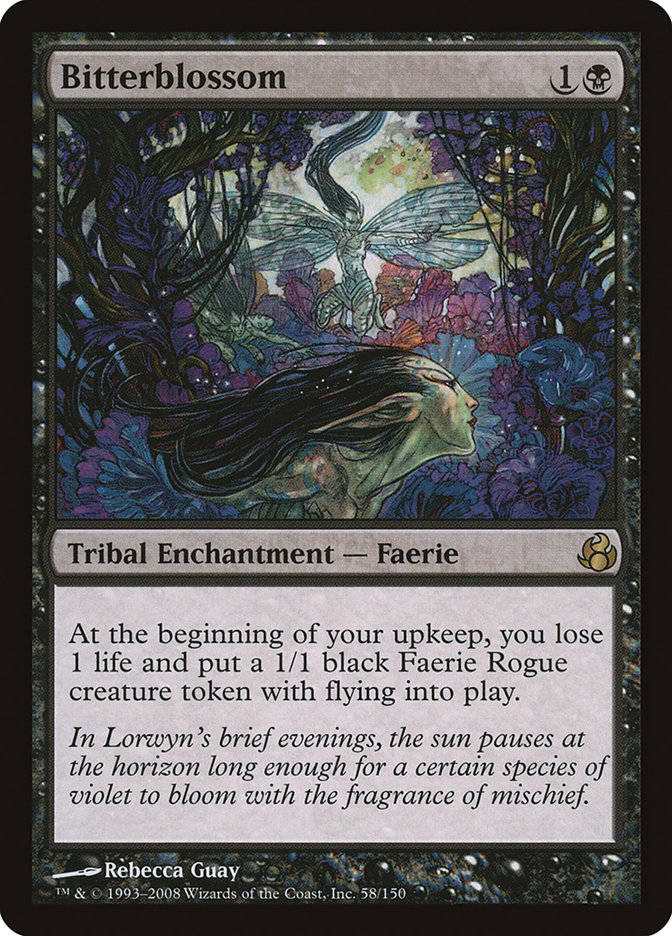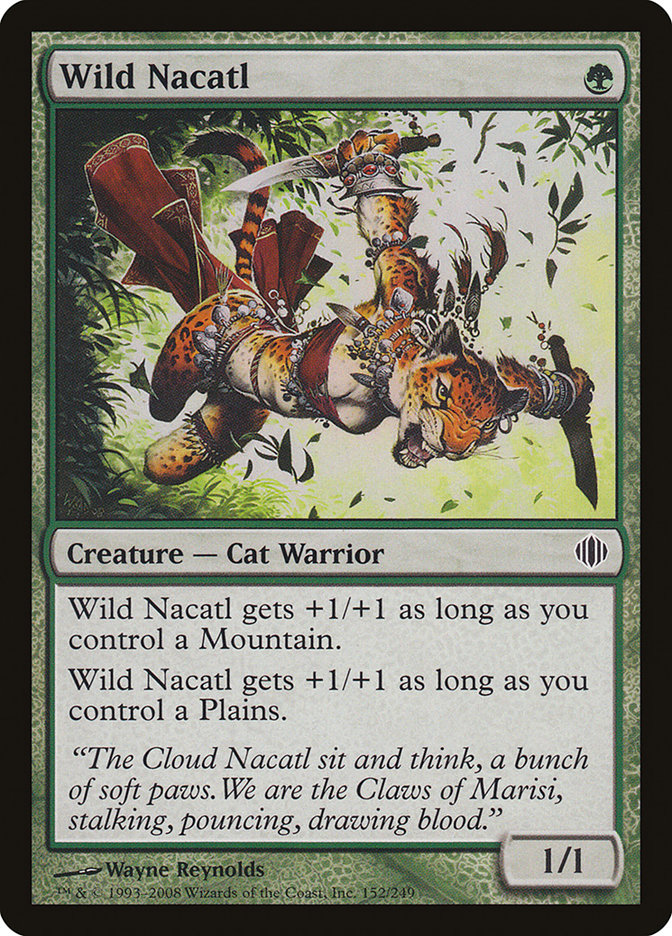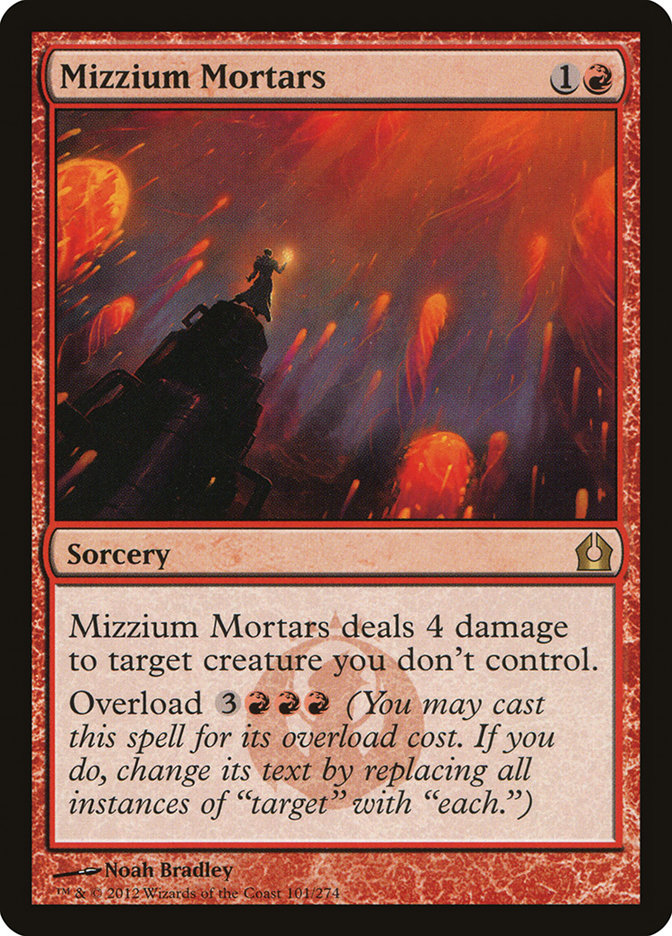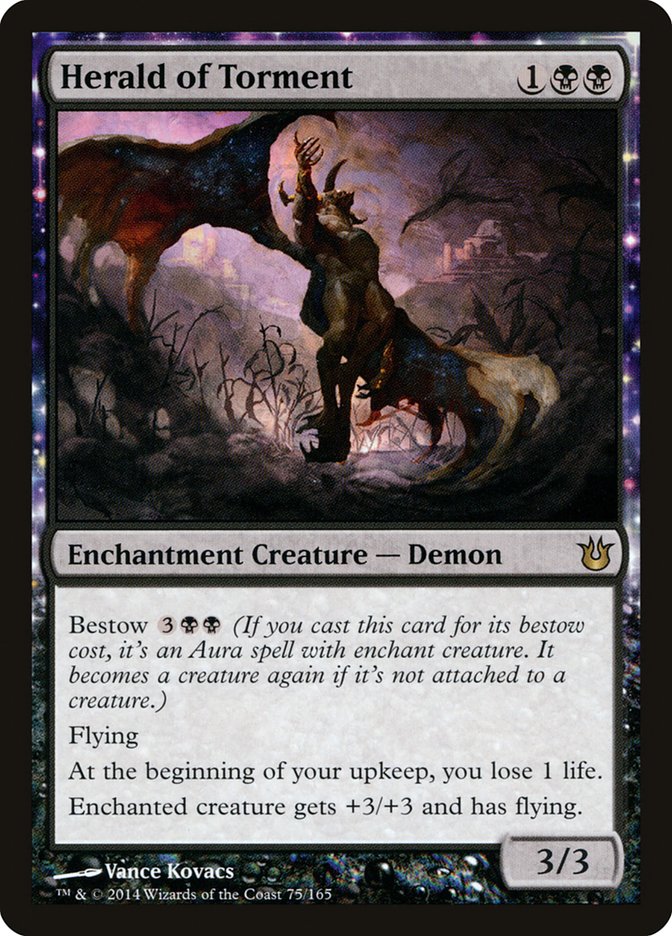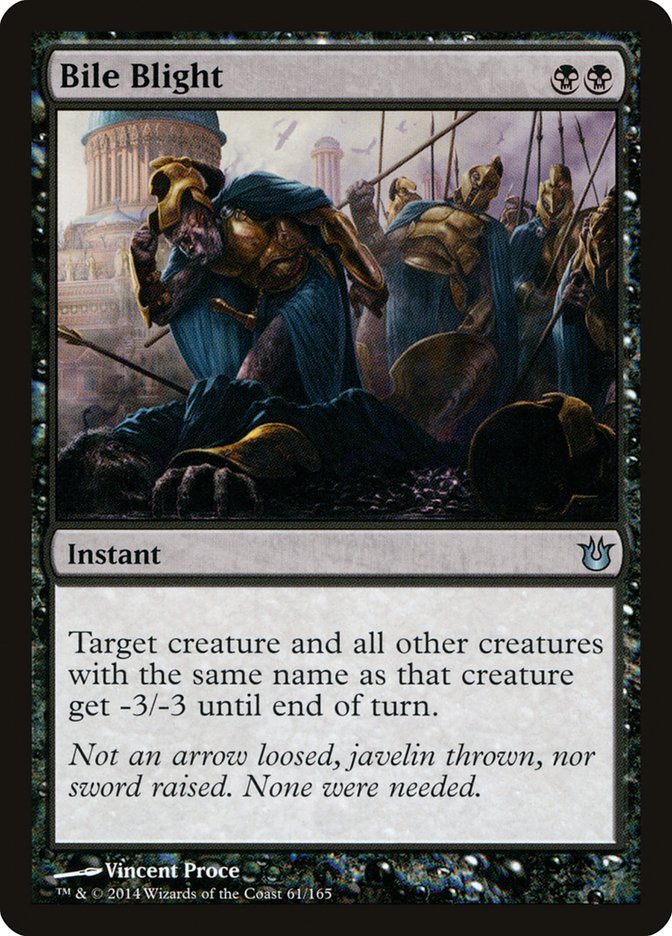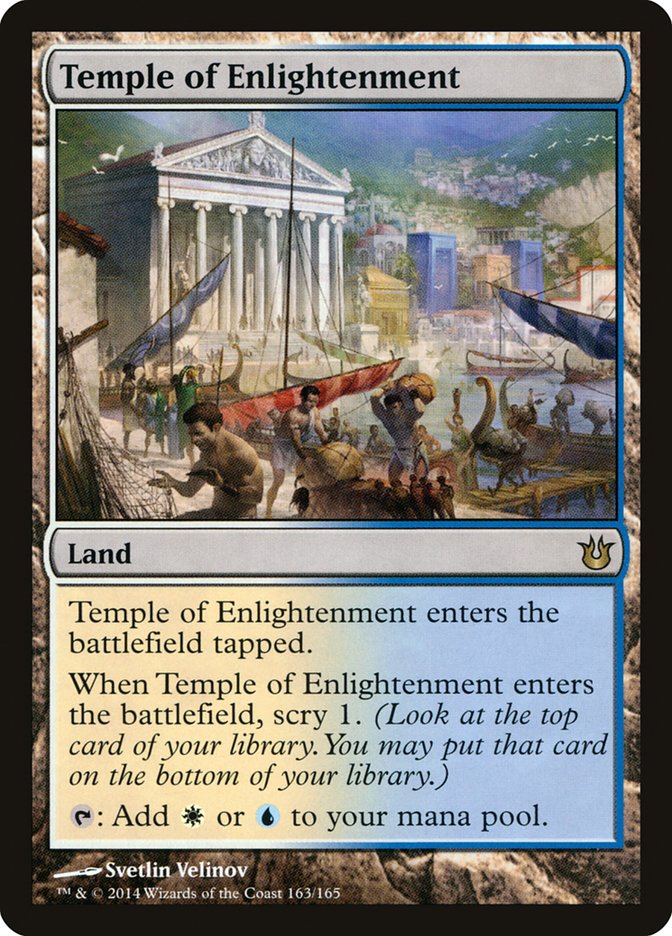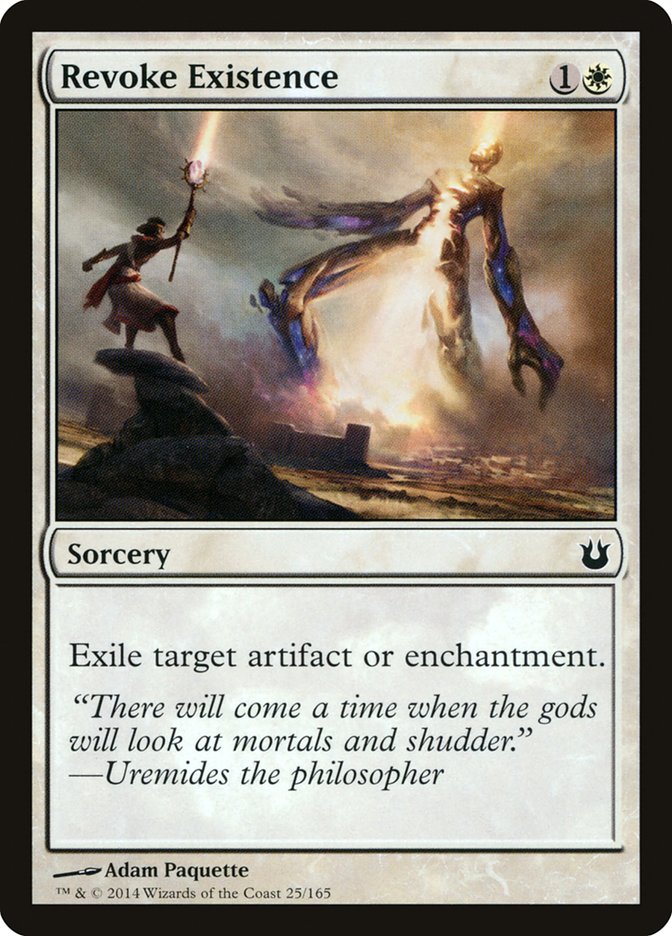The first few weeks following the release of a new set is the worst time for Magic Online players. New sets release two weeks later online than in real life, and the third week consists of rampantly overpriced Prerelease events. Speculators also drive prices sky high, leaving sane players to wait four weeks before getting to play some Constructed with the new cards. Couple this with the extremely late implementation of the Modern banned list changes and I’m left with a gap in my knowledge of Modern. I haven’t had time to test the Top 8 decks from Pro Tour Born of the Gods, but I’m interested in the effect the banned list changes had on the health of the format and whether more action needs to be taken to make Modern a format people can enjoy.
Modern
Here are my thoughts about Modern after seeing the results of Pro Tour Born of the Gods.
Bitterblossom Is Actually Bad
While Faeries is powerful enough with a turn 2 Bitterblossom, games without it are untenable. U/B decks are also short on ways of killing Wild Nacatl and friends, and adding red for Lightning Bolt or white for Path to Exile makes you wonder why you’re bothering with the Fae clan in the first place.
Deathrite Shaman Is Banned
The banning of Deathrite Shaman leads to an increase in the power level of cards and strategies that it was keeping in check. Three I have in mind are:
- Knight of the Reliquary – This three-mana monster needs to not die to Lightning Bolt / Lightning Helix to be playable, which was impossible with Deathrite Shaman removing precious fetch lands.
- Snapcaster Mage – Hard to rely on when your instants and sorceries were not safe in your graveyard.
- Splinter Twin – U/R combo’s worst matchup was G/B/x decks with Deathrite Shaman, Thoughtseize, Dark Confidant, Tarmogoyf, Liliana of the Veil, and Abrupt Decay. This type of midrange was rendered unplayable without its premier one-drop.
Wild Nacatl Is Not As Good As Advertised
Lightning Bolt, Tarmogoyf, Kitchen Finks, and Restoration Angel were commonly played in Modern before Wild Nacatl was unbanned. Add to this an increase in popularity of Snapcaster Mage, Knight of the Reliquary, and Splinter Twin that all prey upon creature decks and you have a format that only needs a minor adjustment (Anger of the Gods) to spell disaster for the Cat clan.
Modern Is Extremely Fast
Six of the Top 8 decks and ten of the Top 16 decks at Pro Tour Born of the Gods were combo decks that are consistently able to kill on turn 4. Affinity and Storm are even capable of winning on turn 3!
With the results of Pro Tour visible to everyone, Grand Prix Richmond can safely be divided into the following archetypes.
Tier 1: Snapcaster Mage, Birthing Pod, Splinter Twin, Storm, Affinity
These are the clear decks to beat, which only having difficult matchups against each other.
Tier 1.5: Wild Nacatl
I generally hate this nomenclature, but Wild Nacatl has its spot here as being favored against anything that is not tier 1.
Tier 2: Green Midrange, Scapeshift, Tron, Living End, Merfolk, Burn, Hate Bears, Auras
Knowing the decks in the format is only half the metagame, as you also need to know how much of the field each deck is comprised of. I expect the second day of Richmond to be at least 40% combo and up to 50% if you consider archetypes like Auras, Affinity, and Burn to be combo. The rest will be Snapcaster Mage and Wild Nacatl, with less than 10% being the rest of the field.
Banning Deathrite Shaman is a case where the cure is worse than the disease. Non-interactive turn 4 combos, midrange not being competitive, and decks that operate solely at flash speed are recipes for a stale format. I anticipate further bannings and unbannings to occur before Modern settles to where Wizards of the Coast wants it to be. Cards I would look at to ban are Birthing Pod, Snapcaster Mage, and Manamorphose, with Bloodbraid Elf, Deathrite Shaman, and Ancestral Vision for unbanning.
Valencia did not only showcase Modern but also how Wizards plans to improve premier event coverage for the future. Coverage of the Pro(motional) Tour needs to engage an audience that is not necessarily familiar with all the cards, utilizing personalities to keep people interested in the downtime and segments with human elements like interviews to give people a personal connection to what is going on so they have a vested interest in outcomes. I understand accuracy takes a backseat to atmosphere and building excitement when it comes to these things, but I was forced to mute the stream multiple times.
- Three commentators talked about how lethal a ten-power Inkmoth Nexus is with Welding Jar backup despite there being an Ancient Grudge in the graveyard (regeneration removes a creature from combat).
- It was suggested that a player cast Chord of Calling in response to a Cryptic Command tapping creatures to find a Village Bell-Ringer (Cryptic command will then tap them all)
- Restoration Angel’s enters the battlefield ability was said to be able to target a Birthing Pod to get an additional usage (Restoration Angel targets non-Angel creatures, not permanents).
Gaffes aside, it was the best coverage Wizards has done to date and bodes well for the future. My only suggestion would be to have the play-by-play commentator in the booth be more familiar with the intricacies of the board state and the overall strategy of each deck.
Standard
We only have a few premier Standard event results to look at, but it seems clear the current deck to beat is G/R Monsters. That suggests that the deck to choose for upcoming events is Mono-Blue Devotion (documented to have a good matchup against G/R in Theros Standard), but the deck has been conspicuously absent. Mono-Blue Devotion seems to be the only deck to be nearly unchanged with the new set, so what did Born of the Gods do to Standard to make Master of Waves bad?
The verdict is in, and Courser of Kruphix is as good as advertised. The big butt and life gain is only part of the package, as overloading Mizzium Mortars or activating monstrosity on Polukranos, World Eater has never been easier with 23 lands; eight mana accelerants; and Xenagos, the Reveler. Some savvy deckbuilders are even splashing black for Ultimate Price and Reaper of the Wilds over Ghor-Clan Rampager and Xenagos, the Reveler to win the mirror match, which is also better against Master of Waves.
Bile Blight was seen on the surface as the answer to the horrendous Mono-Black Devotion mirror match and Pack Rat, but Mono-Blue Devotion is also a victim. Bile Blight replaced Pharika’s Cure in many lists, turning a slot that was normally ineffectual against Frostburn Weird, Nightveil Specter or aggressive Cloudfin Raptors into a hard removal spell. Even worse is that Mono-Blue Devotion is the aggressor in the matchup, needing to play out its hand as quickly as possible before the late game of Desecration Demon and Gray Merchant of Asphodel come online. This leads to games where you’ll have to play out second copies of cards just to keep the pressure on or turn on Thassa, God of the Sea leading to game-losing two-for-one tempo swings from Bile Blight.
Another weapon added to Mono-Black Devotion that hasn’t seen widespread play is Herald of Torment. It took one game piloting Mono-Blue Devotion against it with an opening of Cloudfin Raptor, Judge’s Familiar, and Nightveil Specter to realize I was brick walled with my opponent at sixteen life and no way to punch through. Herald of Torment’s big bro Desecration Demon (aka Double Dee), a removal spell for Master of Waves, and a pair of Gray Merchants later and I was dead, with the life loss upkeep never coming close to mattering.
Temple of Enlightenment adds another level of consistency that erodes the advantage a monocolored deck is supposed to have. In addition, Revoke Existence removes your two greatest threats in Bident of Thassa and Thassa, God of the Sea herself. Alexander Hayne showed us that Archangel of Thune from the sideboard of U/W Control is a huge problem, with narrow cards like Domestication and Rapid Hybridization simply not up to the task of stopping the 3/4 flier. Boarding in counterspells only plays directly into their plan of the game lasting until turn 10, where Sphinx’s Revelation will end you if Jace, Architect of Thought or Elspeth, Sun’s Champion don’t beforehand.
It’s clear with everyone acquiring tools from Born of the Gods that Mono-Blue Devotion needs to adapt. One possible avenue by _Soku_ on Magic Online looks promising:
Creatures (31)
- 4 Judge's Familiar
- 4 Frostburn Weird
- 4 Cloudfin Raptor
- 4 Nightveil Specter
- 4 Tidebinder Mage
- 4 Thassa, God of the Sea
- 4 Master of Waves
- 3 Ephara, God of the Polis
Lands (14)
Spells (16)
Sideboard

Splashing white for Detention Sphere adds free wins, nabbing enemy duplicate permanents; removing roadblocks other than Thassa, God of the Sea; and providing noncreature permanents for devotion against mass removal. Ephara, God of the Polis performs extremely well as a brawler against G/R Monsters while you attack in the air and is extremely tough for Mono-Black Devotion and U/W Control to deal with. White also offers a possible solution to the U/W Control matchup, with Glare of Heresy removing Detention Sphere from Thassa or Ephara. Revoke Existence also exiles Thassa and Domestication in the mirror match, giving you a noticeable edge.
One thing to note with this list is how good Rapid Hybridization is with Ephara, God of the Polis. Using it on your own creature (or even Ephara herself since she can’t be destroyed) on the opponent’s turn will draw you a card because Ephara triggers on each upkeep. Ephara can also "cycle" away multiple copies of herself by playing the second and keeping the one already in play. This action occurs even if Ephara is your sixth and seventh devotion (if your board is Thassa, Detention Sphere, and Ephara for example).
U/W Devotion seems like a decent choice for the SCG Standard Open in Atlanta this weekend, with the only thing I don’t like being the adhesion to the counterspell sideboard plan. With answers in Glare of Heresy and Detention Sphere and the card advantage engines of Bident of Thassa and Ephara, God of the Polis, I question the need for Dissolve against control. It seems that something like Dispel might be better suited to force things through Gainsay.
Is Modern better or worse with Deathrite Shaman gone? Does Mono-Blue Devotion need to evolve to have a chance in Standard? Hopefully we’ll have better answers to those questions sooner rather than later.

